给外国人讲文化之中国茶文化
- 格式:ppt
- 大小:8.52 MB
- 文档页数:8
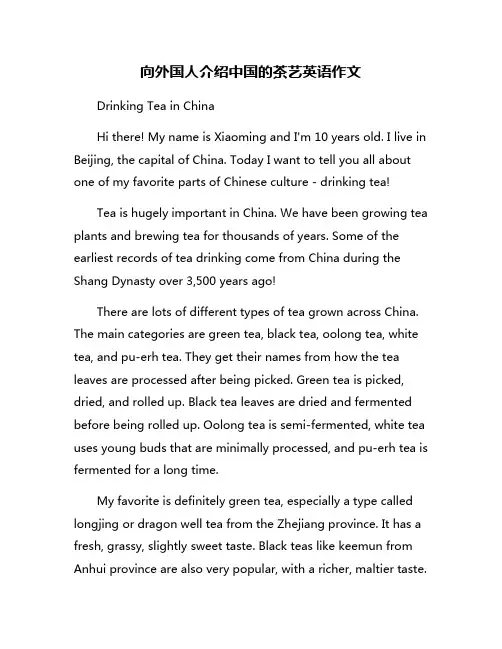
向外国人介绍中国的茶艺英语作文Drinking Tea in ChinaHi there! My name is Xiaoming and I'm 10 years old. I live in Beijing, the capital of China. Today I want to tell you all about one of my favorite parts of Chinese culture - drinking tea!Tea is hugely important in China. We have been growing tea plants and brewing tea for thousands of years. Some of the earliest records of tea drinking come from China during the Shang Dynasty over 3,500 years ago!There are lots of different types of tea grown across China. The main categories are green tea, black tea, oolong tea, white tea, and pu-erh tea. They get their names from how the tea leaves are processed after being picked. Green tea is picked, dried, and rolled up. Black tea leaves are dried and fermented before being rolled up. Oolong tea is semi-fermented, white tea uses young buds that are minimally processed, and pu-erh tea is fermented for a long time.My favorite is definitely green tea, especially a type called longjing or dragon well tea from the Zhejiang province. It has a fresh, grassy, slightly sweet taste. Black teas like keemun from Anhui province are also very popular, with a richer, maltier taste.There's an amazing variety of tea based on where the leaves are grown, how they are processed, when they are harvested, and so on. Top grade teas can be really expensive! Some of the most prized are made from just a few leaves from ancient tea trees in remote mountains.Preparing tea is like an art form in China. There are different traditional ways to brew tea depending on the type. For example, green tea is often brewed in a small teapot and drunk from little cups. The tea leaves are rinsed first before brewing. Pu-erh tea is usually brewed in a special pu-erh teapot where the leaves can be rinsed and re-steeped many times.Drinking tea is a social occasion where people can relax and connect. There are special tea houses and gardens across China where people go to sample different teas. Having a traditional tea ceremony is an important custom for celebrations and hosting guests. Every movement and step in the tea ceremony has meaning.In a full gongfu cha tea ceremony, the tea is prepared by a master in a particular order. They will carefully warm the teapot and cups, measure out the leaves, and brew the tea in a prescribed way. Guests take turns appreciating the aroma andtaste of each brew. It shows great respect to the tea, the ceremony, and each other.Chinese people even use tea for cooking! We have dishes like tea leaf eggs where eggs are boiled in tea and soy sauce until the shells take on a beautiful marbled pattern. There's alsotea-smoked duck where the ducks are smoked over oolong tea leaves. Yum!Tea is considered very healthy in China too. We believe drinking tea, especially green tea, has all sorts of benefits like antioxidants, aiding digestion, and even preventing some diseases. That's why many people drink green tea regularly with meals or whenever they want a warm beverage.I hope you can see why tea is such an important part of Chinese culture! It's our most famous and beloved drink, deeply woven into our history, customs, and way of life. The next time you drink a cup of tea, remember all the generations of Chinese people who enjoyed it too. Why don't you try hosting your own little tea ceremony? You can get a taste of the Chinese tea experience!。
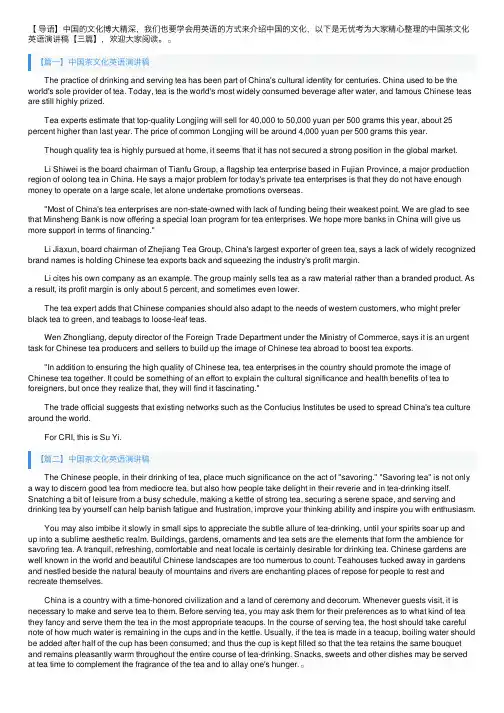
【导语】中国的⽂化博⼤精深,我们也要学会⽤英语的⽅式来介绍中国的⽂化,以下是⽆忧考为⼤家精⼼整理的中国茶⽂化英语演讲稿【三篇】,欢迎⼤家阅读。
【篇⼀】中国茶⽂化英语演讲稿 The practice of drinking and serving tea has been part of China's cultural identity for centuries. China used to be the world's sole provider of tea. Today, tea is the world's most widely consumed beverage after water, and famous Chinese teas are still highly prized. Tea experts estimate that top-quality Longjing will sell for 40,000 to 50,000 yuan per 500 grams this year, about 25 percent higher than last year. The price of common Longjing will be around 4,000 yuan per 500 grams this year. Though quality tea is highly pursued at home, it seems that it has not secured a strong position in the global market. Li Shiwei is the board chairman of Tianfu Group, a flagship tea enterprise based in Fujian Province, a major production region of oolong tea in China. He says a major problem for today's private tea enterprises is that they do not have enough money to operate on a large scale, let alone undertake promotions overseas. "Most of China's tea enterprises are non-state-owned with lack of funding being their weakest point. We are glad to see that Minsheng Bank is now offering a special loan program for tea enterprises. We hope more banks in China will give us more support in terms of financing." Li Jiaxun, board chairman of Zhejiang Tea Group, China's largest exporter of green tea, says a lack of widely recognized brand names is holding Chinese tea exports back and squeezing the industry's profit margin. Li cites his own company as an example. The group mainly sells tea as a raw material rather than a branded product. As a result, its profit margin is only about 5 percent, and sometimes even lower. The tea expert adds that Chinese companies should also adapt to the needs of western customers, who might prefer black tea to green, and teabags to loose-leaf teas. Wen Zhongliang, deputy director of the Foreign Trade Department under the Ministry of Commerce, says it is an urgent task for Chinese tea producers and sellers to build up the image of Chinese tea abroad to boost tea exports. "In addition to ensuring the high quality of Chinese tea, tea enterprises in the country should promote the image of Chinese tea together. It could be something of an effort to explain the cultural significance and health benefits of tea to foreigners, but once they realize that, they will find it fascinating." The trade official suggests that existing networks such as the Confucius Institutes be used to spread China's tea culture around the world. For CRI, this is Su Yi.【篇⼆】中国茶⽂化英语演讲稿 The Chinese people, in their drinking of tea, place much significance on the act of "savoring." "Savoring tea" is not only a way to discern good tea from mediocre tea, but also how people take delight in their reverie and in tea-drinking itself. Snatching a bit of leisure from a busy schedule, making a kettle of strong tea, securing a serene space, and serving and drinking tea by yourself can help banish fatigue and frustration, improve your thinking ability and inspire you with enthusiasm. You may also imbibe it slowly in small sips to appreciate the subtle allure of tea-drinking, until your spirits soar up and up into a sublime aesthetic realm. Buildings, gardens, ornaments and tea sets are the elements that form the ambience for savoring tea. A tranquil, refreshing, comfortable and neat locale is certainly desirable for drinking tea. Chinese gardens are well known in the world and beautiful Chinese landscapes are too numerous to count. Teahouses tucked away in gardens and nestled beside the natural beauty of mountains and rivers are enchanting places of repose for people to rest and recreate themselves. China is a country with a time-honored civilization and a land of ceremony and decorum. Whenever guests visit, it is necessary to make and serve tea to them. Before serving tea, you may ask them for their preferences as to what kind of tea they fancy and serve them the tea in the most appropriate teacups. In the course of serving tea, the host should take careful note of how much water is remaining in the cups and in the kettle. Usually, if the tea is made in a teacup, boiling water should be added after half of the cup has been consumed; and thus the cup is kept filled so that the tea retains the same bouquet and remains pleasantly warm throughout the entire course of tea-drinking. Snacks, sweets and other dishes may be served at tea time to complement the fragrance of the tea and to allay one's hunger.【篇三】中国茶⽂化英语演讲稿 Ladies and Gentlemen: It’s my honor to stand here and make a speech. My topic is “Chinese Tea Culture”. Do you know the name of the three most famous drinks in the world? They are tea , coffee and cocoa. China is the homeland of tea which has become the national drink. In other words, tea is basically spread out from China. Referring to Chinese tea culture, it has several thousand years of history and can be traced back to the ancient times. Then it was flourished in the Tang dynasty and the Song dynasty. At first, our ancients found tea make them excited, but they thought that drinking more would be destructive to the morals. As time went by, tea became popular among likeminded people, Confucianism, Taoism, Buddhism and cultivation culture. Until Tang Dynasty, tea culture began taking shape. When it came to Song Dynasty, tea culture became thriving. When people migrated, they would offer tea. When people engaged, they would send tea. When people got married, they would settle tea. Tea became an important part in their daily life. In china, the main varieties of tea are green tea, black tea, Oolong tea, scented tea, white tea, yellow tea and dark tea. In the early days, the Chinese boiled their tea leaves with water and other ingredients such as salt and ginger; later they ground the dried leaves to a powder and whipped them up with hot water. It was not until that Ming Dynasty that it became common practice to infuse the loose tea leaves in hot water in teapots, and then to pour the infused liquid into bowls to drink. Nowadays, we make different tea in different particular ways. Over the centuries, China developed an extraordinary tea culture, comparable with the wine culture of the West. Tea not only has a good flavor but also benefit to our body, so it is loved by many people home and abroad. Different kinds of tea have different function which makes a contribution to our health. For example, the national drink of China-green tea, can dispel the effects of alcohol, clear away summer-heat, refresh yourself and whiten your skin. The second largest kind of tea-black tea, can warm your stomach, be good for your heart and make your bones stronger. Dark tea can refresh you in the morning, reduce your blood press and help lose weight. Oolong Tea is good for your body building and dieting. In all, tea have great medicinal value, anti-cancer, lowering blood pressure, improving eyesight and restraining disease, reducing stress and so on. Tea culture and its development reflect not only diet culture, but also Chinese spiritual features. China is a country with a time-honored civilization and a land of ceremony and decorum. Whenever guests visit, it is necessary to make and serve tea to them. Before serving tea, you may ask them for their preferences as to what kind of tea they fancy and serve them the tea in the most appropriate teacups. In the course of serving tea, the host should take careful note of how much water is remaining in the cups and in the kettle. Usually, if the tea is made in a teacup, boiling water should be added after half of the cup has been consumed; and thus the cup is kept filled so that the tea retains the same bouquet and remains pleasantly warm. Tea culture plays an indispensable role in promoting the international cultural exchange between China and other countries, enriching Chinese cultural life and promoting Chinese spiritual civilization construction. In conclusion, tea culture is one of the essences of Chinese culture in the history. The spirit of tea permeates the court and society, into the Chinese poetry, painting, calligraphy, religion, medicine. For thousands of years China has not only accumulated a great deal about tea cultivation, production of material culture, but also accumulated rich spirit of the tea culture, which is unique to China's tea culture. Thank you!。
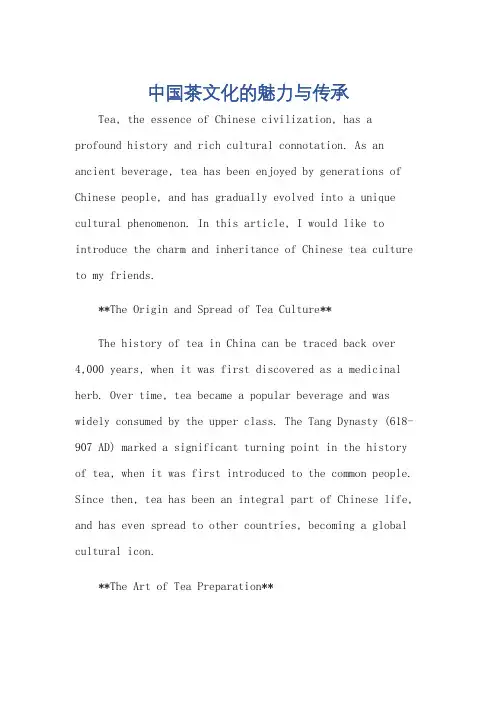
中国茶文化的魅力与传承Tea, the essence of Chinese civilization, has a profound history and rich cultural connotation. As an ancient beverage, tea has been enjoyed by generations of Chinese people, and has gradually evolved into a unique cultural phenomenon. In this article, I would like to introduce the charm and inheritance of Chinese tea culture to my friends.**The Origin and Spread of Tea Culture**The history of tea in China can be traced back over 4,000 years, when it was first discovered as a medicinal herb. Over time, tea became a popular beverage and was widely consumed by the upper class. The Tang Dynasty (618-907 AD) marked a significant turning point in the history of tea, when it was first introduced to the common people. Since then, tea has been an integral part of Chinese life, and has even spread to other countries, becoming a global cultural icon.**The Art of Tea Preparation**Preparing tea is not just about pouring water into acup of leaves; it's an elaborate art form that requiresskill and patience. The process begins with selecting the right tea, which can range from green, black, white, oolong, and pu-erh, each with its unique flavor and aroma. The next step is to boil the water to the perfect temperature, which varies depending on the type of tea. Finally, the tea is poured into a teapot or teacup, and enjoyed slowly, appreciating its color, aroma, and taste.**The Symbolic Meaning of Tea**In Chinese culture, tea is not just a beverage; it's a symbol of respect, friendship, and harmony. Tea is often served during important occasions, such as businessmeetings or social gatherings, as a way to show hospitality and foster relationships. The act of sharing tea is considered a bonding experience that brings people together and strengthens social bonds.**The Modern Relevance of Tea Culture**In the modern era, tea culture has not only survivedbut also thrived. With the increasing popularity of health and wellness, tea has emerged as a healthy alternative tocoffee and other caffeinated drinks. Tea shops and teahouses have become popular hangouts for people to relax, socialize, and enjoy a cup of good tea. Furthermore, tea culture has also been integrated into various art forms, such as tea painting and tea poetry, further enriching its cultural value.**Conclusion**Chinese tea culture is a rich and diverse heritage that has stood the test of time. It embodies the essence of Chinese civilization, reflecting its values and traditions. As we continue to embrace the modern world, it is important to cherish and inherit this cultural treasure, allowing its charm and wisdom to enlighten and enrich our lives.**中国茶文化的魅力与传承**茶,作为中华文明的精髓,拥有悠久的历史和丰富的文化内涵。
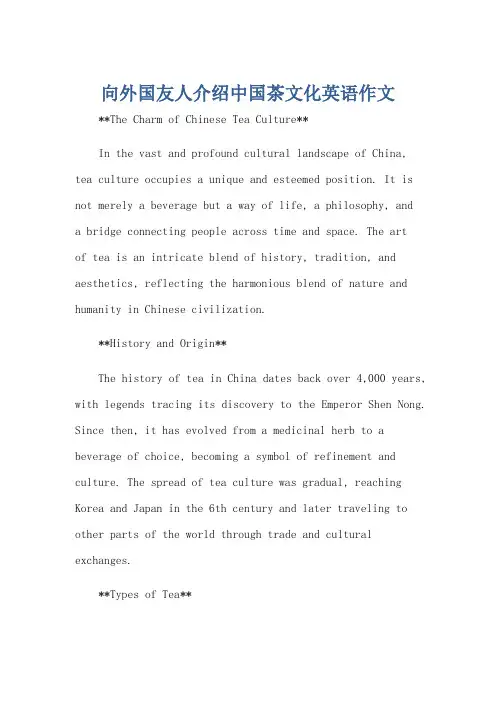
向外国友人介绍中国茶文化英语作文**The Charm of Chinese Tea Culture**In the vast and profound cultural landscape of China,tea culture occupies a unique and esteemed position. It is not merely a beverage but a way of life, a philosophy, anda bridge connecting people across time and space. The artof tea is an intricate blend of history, tradition, and aesthetics, reflecting the harmonious blend of nature and humanity in Chinese civilization.**History and Origin**The history of tea in China dates back over 4,000 years, with legends tracing its discovery to the Emperor Shen Nong. Since then, it has evolved from a medicinal herb to a beverage of choice, becoming a symbol of refinement and culture. The spread of tea culture was gradual, reaching Korea and Japan in the 6th century and later traveling to other parts of the world through trade and cultural exchanges.**Types of Tea**China boasts a diverse array of teas, each with its unique flavor, aroma, and brewing method. The most common types include green tea, black tea, white tea, oolong tea, and puerh tea. Each type is produced from different varieties of the Camellia sinensis plant and undergoes specific processing techniques to achieve the desiredflavor and quality.**Tea-Drinking Rituals**The art of tea drinking is as intricate as the teas themselves. It involves the selection of high-quality tea leaves, the use of specific brewing techniques, and the appreciation of the tea's color, aroma, taste, and aftertaste. The preparation of tea is often a ceremony in itself, with specific gestures and movements designed to invoke a sense of peace and tranquility.**Tea and Society**Tea is not just a beverage in China; it is a social lubricant, a medium for communication, and a symbol of respect and friendship. It is offered as a gesture of hospitality and is consumed during social gatherings, business meetings, and ceremonial occasions. Tea houses andtea ceremonies are commonplaces for people to gather, chat, and relax.**Tea and Health**Tea is also renowned for its health benefits. It contains antioxidants and various nutrients that are beneficial for the body. Regular consumption of tea is believed to promote good health, improve digestion, and enhance mental clarity.**Conclusion**In conclusion, Chinese tea culture is a rich and profound tradition that encapsulates the essence of Chinese civilization. It is a beverage of choice, a means of social interaction, a symbol of cultural refinement, and a vehicle for personal growth and relaxation. As we delve into the world of Chinese tea, we embark on a journey that transcends taste and touches the soul.**中国茶文化的魅力**中国茶文化源远流长,博大精深,它不仅仅是一种饮品,更是一种生活方式、一种哲学思想,是连接古今中外的桥梁。
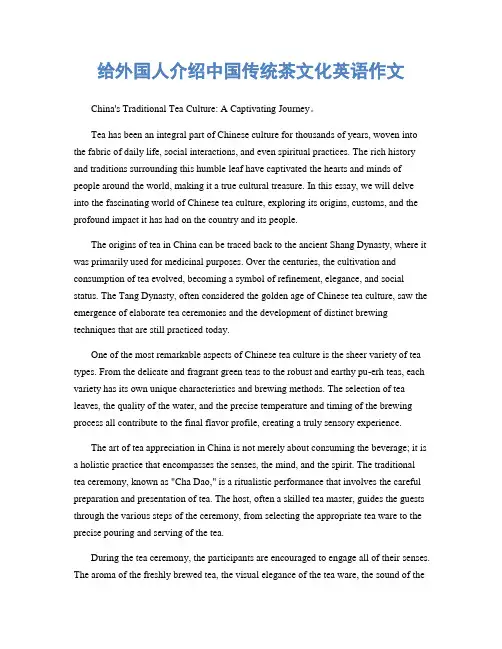
给外国人介绍中国传统茶文化英语作文China's Traditional Tea Culture: A Captivating Journey。
Tea has been an integral part of Chinese culture for thousands of years, woven into the fabric of daily life, social interactions, and even spiritual practices. The rich history and traditions surrounding this humble leaf have captivated the hearts and minds of people around the world, making it a true cultural treasure. In this essay, we will delve into the fascinating world of Chinese tea culture, exploring its origins, customs, and the profound impact it has had on the country and its people.The origins of tea in China can be traced back to the ancient Shang Dynasty, where it was primarily used for medicinal purposes. Over the centuries, the cultivation and consumption of tea evolved, becoming a symbol of refinement, elegance, and social status. The Tang Dynasty, often considered the golden age of Chinese tea culture, saw the emergence of elaborate tea ceremonies and the development of distinct brewing techniques that are still practiced today.One of the most remarkable aspects of Chinese tea culture is the sheer variety of tea types. From the delicate and fragrant green teas to the robust and earthy pu-erh teas, each variety has its own unique characteristics and brewing methods. The selection of tea leaves, the quality of the water, and the precise temperature and timing of the brewing process all contribute to the final flavor profile, creating a truly sensory experience.The art of tea appreciation in China is not merely about consuming the beverage; it is a holistic practice that encompasses the senses, the mind, and the spirit. The traditional tea ceremony, known as "Cha Dao," is a ritualistic performance that involves the careful preparation and presentation of tea. The host, often a skilled tea master, guides the guests through the various steps of the ceremony, from selecting the appropriate tea ware to the precise pouring and serving of the tea.During the tea ceremony, the participants are encouraged to engage all of their senses. The aroma of the freshly brewed tea, the visual elegance of the tea ware, the sound of thewater being poured, and the tactile experience of holding the delicate cups all contribute to the overall experience. The act of sipping the tea is not merely about quenching one's thirst; it is a moment of contemplation, where the drinker is encouraged to savor the flavors, textures, and aromas, and to connect with the rich history and cultural significance of the tea.Beyond the formal tea ceremonies, tea drinking is deeply woven into the fabric of everyday Chinese life. Families and friends gather around the tea table to discuss business, share stories, and simply enjoy each other's company. The tea house, a ubiquitous feature in Chinese cities, serves as a hub for social interaction, where people come to relax, exchange ideas, and immerse themselves in the timeless tradition of tea drinking.The influence of Chinese tea culture extends far beyond the borders of the country. The art of tea cultivation, brewing, and appreciation has spread to various parts of the world, inspiring a global fascination with this ancient practice. Many countries have embraced Chinese tea traditions and incorporated them into their own cultural practices, further enriching the global tea landscape.In conclusion, Chinese tea culture is a captivating and multifaceted aspect of the country's rich heritage. From its humble beginnings as a medicinal herb to its current status as a symbol of refinement and social connection, tea has played a pivotal role in shaping the cultural identity of China. As we delve deeper into this enchanting world, we can't help but be awed by the depth of knowledge, the attention to detail, and the reverence for tradition that permeates every aspect of Chinese tea culture.。
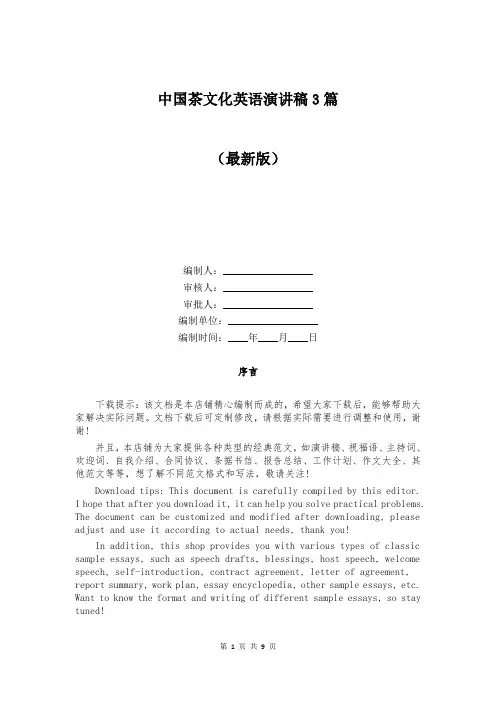
中国茶文化英语演讲稿3篇(最新版)编制人:__________________审核人:__________________审批人:__________________编制单位:__________________编制时间:____年____月____日序言下载提示:该文档是本店铺精心编制而成的,希望大家下载后,能够帮助大家解决实际问题。
文档下载后可定制修改,请根据实际需要进行调整和使用,谢谢!并且,本店铺为大家提供各种类型的经典范文,如演讲稿、祝福语、主持词、欢迎词、自我介绍、合同协议、条据书信、报告总结、工作计划、作文大全、其他范文等等,想了解不同范文格式和写法,敬请关注!Download tips: This document is carefully compiled by this editor.I hope that after you download it, it can help you solve practical problems. The document can be customized and modified after downloading, please adjust and use it according to actual needs, thank you!In addition, this shop provides you with various types of classic sample essays, such as speech drafts, blessings, host speech, welcome speech, self-introduction, contract agreement, letter of agreement, report summary, work plan, essay encyclopedia, other sample essays, etc. Want to know the format and writing of different sample essays, so stay tuned!中国茶文化英语演讲稿3篇英语演讲,是指以英语为载体,针对某个话题发表自己的意见和看法,以此来影响、感染听众,达到一种宣传目的的交际活动。
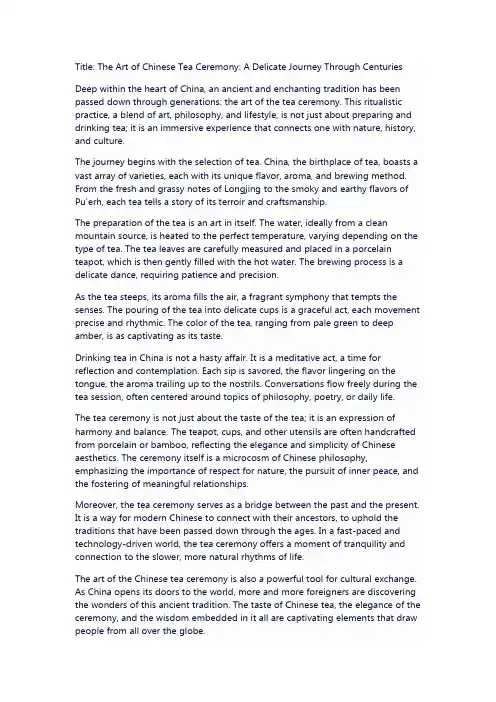
Title: The Art of Chinese Tea Ceremony: A Delicate Journey Through Centuries Deep within the heart of China, an ancient and enchanting tradition has been passed down through generations: the art of the tea ceremony. This ritualistic practice, a blend of art, philosophy, and lifestyle, is not just about preparing and drinking tea; it is an immersive experience that connects one with nature, history, and culture.The journey begins with the selection of tea. China, the birthplace of tea, boasts a vast array of varieties, each with its unique flavor, aroma, and brewing method. From the fresh and grassy notes of Longjing to the smoky and earthy flavors of Pu'erh, each tea tells a story of its terroir and craftsmanship.The preparation of the tea is an art in itself. The water, ideally from a clean mountain source, is heated to the perfect temperature, varying depending on the type of tea. The tea leaves are carefully measured and placed in a porcelain teapot, which is then gently filled with the hot water. The brewing process is a delicate dance, requiring patience and precision.As the tea steeps, its aroma fills the air, a fragrant symphony that tempts the senses. The pouring of the tea into delicate cups is a graceful act, each movement precise and rhythmic. The color of the tea, ranging from pale green to deep amber, is as captivating as its taste.Drinking tea in China is not a hasty affair. It is a meditative act, a time for reflection and contemplation. Each sip is savored, the flavor lingering on the tongue, the aroma trailing up to the nostrils. Conversations flow freely during the tea session, often centered around topics of philosophy, poetry, or daily life.The tea ceremony is not just about the taste of the tea; it is an expression of harmony and balance. The teapot, cups, and other utensils are often handcrafted from porcelain or bamboo, reflecting the elegance and simplicity of Chinese aesthetics. The ceremony itself is a microcosm of Chinese philosophy, emphasizing the importance of respect for nature, the pursuit of inner peace, and the fostering of meaningful relationships.Moreover, the tea ceremony serves as a bridge between the past and the present. It is a way for modern Chinese to connect with their ancestors, to uphold the traditions that have been passed down through the ages. In a fast-paced and technology-driven world, the tea ceremony offers a moment of tranquility and connection to the slower, more natural rhythms of life.The art of the Chinese tea ceremony is also a powerful tool for cultural exchange. As China opens its doors to the world, more and more foreigners are discovering the wonders of this ancient tradition. The taste of Chinese tea, the elegance of the ceremony, and the wisdom embedded in it all are captivating elements that draw people from all over the globe.In conclusion, the Chinese tea ceremony is not just a way to enjoy a cup of tea; it is a journey through history, culture, and the soul of China. It is a practice that nurtures the spirit, fosters community, and honors the legacy of centuries. As you sip a cup of Chinese tea, let its rich flavor and aroma transport you to a world of tranquility, wisdom, and beauty.。
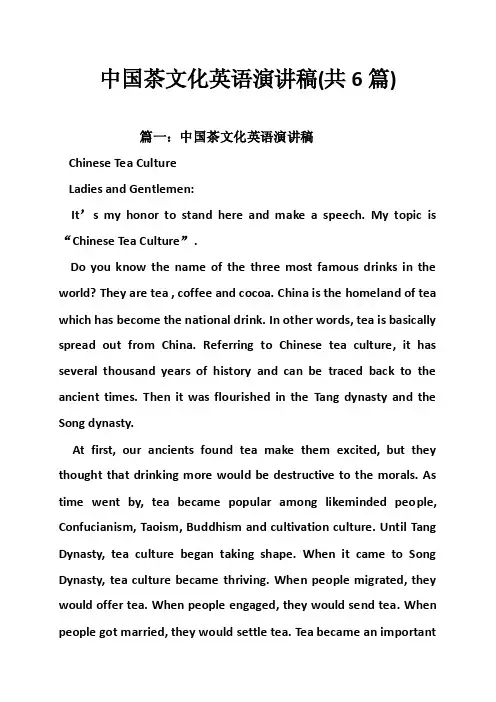
中国茶文化英语演讲稿(共6篇)篇一:中国茶文化英语演讲稿Chinese Tea CultureLadies and Gentlemen:It’s my honor to stand here and make a speech. My topic is “Chinese Tea Culture”.Do you know the name of the three most famous drinks in the world? They are tea , coffee and cocoa. China is the homeland of tea which has become the national drink. In other words, tea is basically spread out from China. Referring to Chinese tea culture, it has several thousand years of history and can be traced back to the ancient times. Then it was flourished in the Tang dynasty and the Song dynasty.At first, our ancients found tea make them excited, but they thought that drinking more would be destructive to the morals. As time went by, tea became popular among likeminded people, Confucianism, Taoism, Buddhism and cultivation culture. Until Tang Dynasty, tea culture began taking shape. When it came to Song Dynasty, tea culture became thriving. When people migrated, they would offer tea. When people engaged, they would send tea. When people got married, they would settle tea. Tea became an importantpart in their daily life.In china, the main varieties of tea are green tea, blacktea, Oolong tea, scented tea, white tea, yellow tea and dark tea. In the early days, the Chinese boiled their tea leaves with water and other ingredients such as salt and ginger; later they ground the dried leaves to a powder and whipped them up with hot water. It was not until that Ming Dynasty that it became common practice to infuse the loose tea leaves in hot water in teapots, and then to pour the infused liquid into bowls to drink. Nowadays, we make different tea in different particular ways. Over the centuries, China developed an extraordinary tea culture, comparable with the wine culture of the West.Tea not only has a good flavor but also benefit to our body, so it is loved by many people home and abroad. Different kinds of tea have different function which makes a contribution to our health. For example, the national drink of China-green tea, can dispel the effects of alcohol, clear away summer-heat, refresh yourself and whiten your skin. The second largest kind of tea-black tea, can warm your stomach, be good for your heart and make your bones stronger. Dark tea can refresh you in the morning, reduce your blood press and help lose weight. Oolong Tea is good for your body building and dieting. In all, tea have great medicinal value,anti-cancer, lowering blood pressure, improving eyesight and restraining disease, reducing stress and so on.Tea culture and its development reflect not only diet culture, but also Chinese spiritual features.China is a country with a time-honored civilization and a land of ceremony and decorum. Whenever guests visit, it is necessary to make and serve tea to them. Before serving tea, you may ask them for their preferences as to what kind of tea they fancy and serve them the tea in the most appropriate teacups. In the course of serving tea, the host should take careful note of how much water is remaining in the cups and in the kettle. Usually, if the tea is made in a teacup, boiling water should be added after half of the cup has been consumed; and thus the cup is kept filled so that the tea retains the same bouquet and remains pleasantly warm.Tea culture plays an indispensable role in promoting the international cultural exchange between China and other countries, eiching Chinese cultural life and promoting Chinese spiritual civilization construction.In conclusion, tea culture is one of the essences of Chinese culture in the history. The spirit of tea permeates the court and society, into the Chinese poetry, painting,calligraphy, religion, medicine. For thousands of years China hasnot only accumulated a great deal about tea cultivation, production of material culture, but also accumulated rich spirit of the tea culture, which is unique to China's tea culture.Thank you!篇二:中国茶文化英语演讲稿Chinese Tea Culture中国的茶文化Ladies and Gentlemen:It’s my honor to stand here and make a speech. My topic is “Chinese Tea Culture”.这是我的荣幸站在这里做一个演讲。
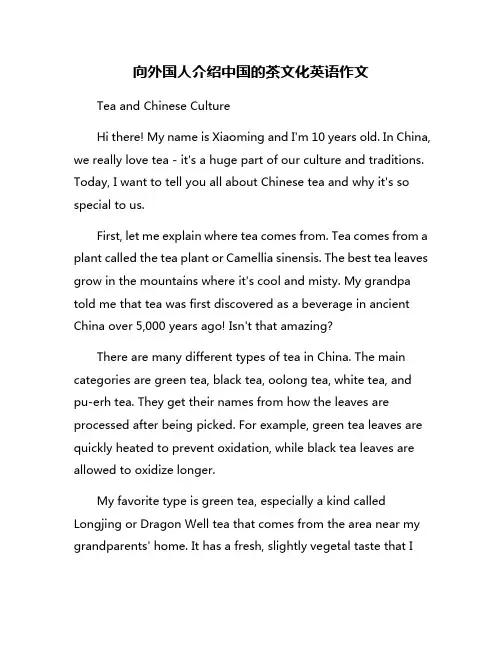
向外国人介绍中国的茶文化英语作文Tea and Chinese CultureHi there! My name is Xiaoming and I'm 10 years old. In China, we really love tea - it's a huge part of our culture and traditions. Today, I want to tell you all about Chinese tea and why it's so special to us.First, let me explain where tea comes from. Tea comes from a plant called the tea plant or Camellia sinensis. The best tea leaves grow in the mountains where it's cool and misty. My grandpa told me that tea was first discovered as a beverage in ancient China over 5,000 years ago! Isn't that amazing?There are many different types of tea in China. The main categories are green tea, black tea, oolong tea, white tea, and pu-erh tea. They get their names from how the leaves are processed after being picked. For example, green tea leaves are quickly heated to prevent oxidation, while black tea leaves are allowed to oxidize longer.My favorite type is green tea, especially a kind called Longjing or Dragon Well tea that comes from the area near my grandparents' home. It has a fresh, slightly vegetal taste that Ireally enjoy. Oolong tea is another popular one - it's somewhere in between green and black tea in how it's processed.No matter what kind of tea, we take the whole process of making and drinking it very seriously in China. The leaves have to be prepared just right, and the water has to be the perfect temperature. We use special tea pots, cups, and other tools just for brewing and serving tea properly.Having a cup of tea is much more than just drinking a beverage for us. It's a chance to slow down, appreciate the taste and aroma, and connect with friends or family. We'll often pair different types of tea with little snacks like sunflower seeds, nuts, or preserved fruits.There are even special tea houses and gardens where people can go to sample various premium loose leaf teas. The server has to be highly trained in things like the gongfu tea ceremony, which involves rinsing the pot, controlling the brew time exactly, and more. It's like an art form!Tea is also used in Chinese traditional medicine and is believed to have many health benefits. Different teas are used to help with various issues like headaches, sleeplessness, digestion problems, and more. My grandma always gives me a specialpu-erh tea when I have a stomachache that seems to help.Certain teas and tea ceremonies are tied to important festivals and holidays too. For example, during the Qingming Festival in early April, we'll drink a special green tea and eat greenish colored foods to welcome spring. The Chinese New Year is another time when exchanging fancy tea is very common as a sign of respect.There are so many stories, customs, and traditions surrounding tea in Chinese culture that it's hard to cover them all. Making and sharing tea with others is just a way of life that has been passed down through thousands of years of history. It connects us to our ancestors and our roots.I hope you've learned a bit more about why tea is so meaningful for Chinese people from reading this. Next time you drink a cup of tea, I hope you'll think about its origins in my home country and the generations of cultivators, farmers, and tea masters who helped bring it to you. Maybe you can even try out some of the gongfu tea ceremony steps yourself! Just remember to appreciate every sip.。
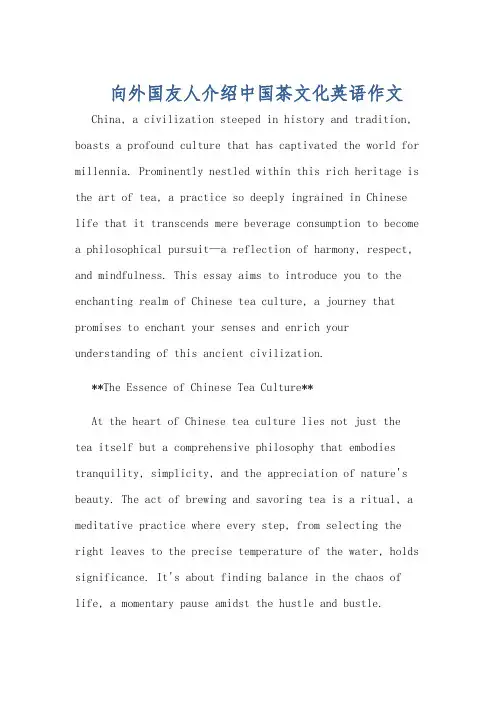
向外国友人介绍中国茶文化英语作文China, a civilization steeped in history and tradition, boasts a profound culture that has captivated the world for millennia. Prominently nestled within this rich heritage is the art of tea, a practice so deeply ingrained in Chinese life that it transcends mere beverage consumption to become a philosophical pursuit—a reflection of harmony, respect, and mindfulness. This essay aims to introduce you to the enchanting realm of Chinese tea culture, a journey that promises to enchant your senses and enrich your understanding of this ancient civilization.**The Essence of Chinese Tea Culture**At the heart of Chinese tea culture lies not just the tea itself but a comprehensive philosophy that embodies tranquility, simplicity, and the appreciation of nature's beauty. The act of brewing and savoring tea is a ritual, a meditative practice where every step, from selecting the right leaves to the precise temperature of the water, holds significance. It's about finding balance in the chaos of life, a momentary pause amidst the hustle and bustle.**Types of Chinese Tea**China is renowned for its vast array of teas, classified primarily into six categories: Green (Lu Cha), Black (Hong Cha), Oolong (Wu Long Cha), White (Bai Cha), Yellow (Huang Cha), and Dark or Pu-erh (Pu Er Cha). Each variety has its unique flavor profile, processing method, and health benefits. For instance, green tea, like the famous Longjing, is prized for its fresh, grassy taste and high antioxidant content, while Pu-erh, often aged, offers a complex, earthy flavor and is believed to aid digestion.**Tea Ceremonies and Traditions**The Gongfu tea ceremony exemplifies the meticulousness and respect inherent in Chinese tea culture. Performed with great care, it involves the use of small teapots and cups, allowing for multiple infusions of the same leaves. Every gesture, from the gentle warming of the pot to the precise pouring of the tea, is executed with grace and intention, fostering an atmosphere of tranquility and camaraderie among participants.**Teahouses and Social Interaction**Teahouses in China are more than just places to drink tea; they serve as community hubs where people gather to socialize, discuss business, or simply enjoy a moment of respite. Amidst the aroma of freshly brewed tea,friendships are forged, and stories are shared, reinforcing the communal aspect of tea culture.**Conclusion**In essence, Chinese tea culture is a living testament to the country's profound appreciation for beauty, harmony, and the simple pleasures of life. It is an invitation to slow down, to savor each sip, and to find solace in the rituals that connect us to our past and to one another. As Confucius once said, "He who knows others is wise; he who knows himself is enlightened." In the quiet moments shared over a cup of tea, we may indeed find both wisdom and enlightenment.---**中国茶文化的介绍**中国,一个历史悠久、传统深厚的文明,其丰富文化遗产中深深植根着茶艺——这一超越了单纯饮品消费、成为哲学追求的艺术。
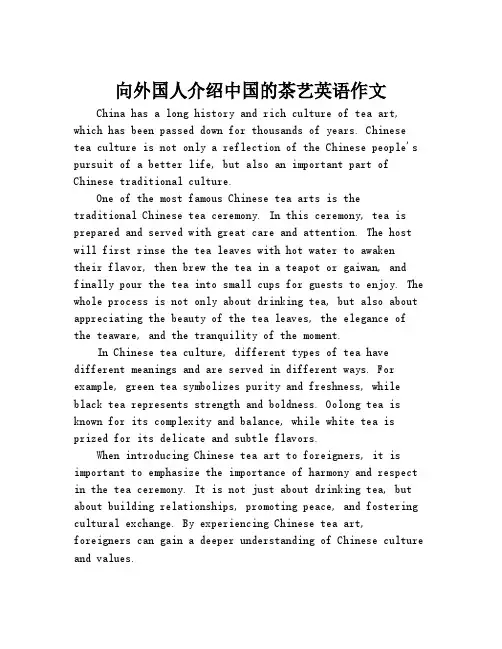
向外国人介绍中国的茶艺英语作文China has a long history and rich culture of tea art, which has been passed down for thousands of years. Chinese tea culture is not only a reflection of the Chinese people's pursuit of a better life, but also an important part of Chinese traditional culture.One of the most famous Chinese tea arts is thetraditional Chinese tea ceremony. In this ceremony, tea is prepared and served with great care and attention. The host will first rinse the tea leaves with hot water to awakentheir flavor, then brew the tea in a teapot or gaiwan, and finally pour the tea into small cups for guests to enjoy. The whole process is not only about drinking tea, but also about appreciating the beauty of the tea leaves, the elegance of the teaware, and the tranquility of the moment.In Chinese tea culture, different types of tea have different meanings and are served in different ways. For example, green tea symbolizes purity and freshness, while black tea represents strength and boldness. Oolong tea is known for its complexity and balance, while white tea is prized for its delicate and subtle flavors.When introducing Chinese tea art to foreigners, it is important to emphasize the importance of harmony and respect in the tea ceremony. It is not just about drinking tea, but about building relationships, promoting peace, and fostering cultural exchange. By experiencing Chinese tea art, foreigners can gain a deeper understanding of Chinese culture and values.In conclusion, Chinese tea art is a beautiful andintricate part of Chinese culture that has captivated people all over the world. By learning about tea art, foreigners can appreciate the beauty and depth of Chinese traditions and customs. Let us continue to share the joy and beauty of Chinese tea art with the world!。
给外国人介绍中国传统茶文化英语作文China has a rich and long-standing tradition of tea culture, which dates back thousands of years. Tea is not just a beverage in China, but also a way of life and an integral part of Chinese society.Tea was first discovered in China and has since become an important aspect of Chinese culture. The Chinese believe that tea has many health benefits and drinking tea is seen as a way to maintain good health and promote longevity.There are many different types of tea in China, each with its own unique flavor and characteristics. Some of the most popular types of tea in China include green tea, black tea, oolong tea, and pu'er tea. Each type of tea is brewed and enjoyed in a different way, with specific rituals and customs associated with each.One of the most famous tea ceremonies in China is the traditional Chinese tea ceremony, which is a formal and elegant way of preparing and serving tea. During the tea ceremony, the tea master will carefully prepare the teausing precise movements and rituals, and then serve the tea to guests in a calm and respectful manner.Tea houses are also an important part of Chinese tea culture, where people can gather to enjoy a cup of tea, socialize, and relax. Tea houses are often decorated in a traditional Chinese style, with beautiful teapots, cups, and other tea utensils on display.Overall, Chinese tea culture is an important part of Chinese heritage and is deeply rooted in the country's history and traditions. It is a way for people to connect with each other, relax, and appreciate the beauty of nature through the simple act of drinking tea.中国有着悠久而丰富的茶文化传统,可以追溯到数千年前。
茶文化介绍[介绍茶文化的英语作文欣赏]向外国朋友介绍中国的茶文化,可以从很多方面来描写。
那么茶文化英语作文有哪些呢?下面是小编精心为你整理的介绍茶文化的英语作文,一起来看看。
介绍茶文化的英语作文1TheCultureofTeaWhenaguestcomestomyhomefromafaronacoldnight,Ilightbambo otoboilteatoofferhim.AncientChinesepoem.Chinaisthehomec ountryoftea.BeforetheTangDynasty,Chineseteawasexportedb ylandandsea,firsttoJapanandKorea,thentoIndiaandCentralA siaand,intheMingandQingdynasties,totheArabianPeninsula. Intheearlyperiodofthe17thcentury,Chineseteawasexportedt oEurope,wheretheupperclassadoptedthefashionofdrinkingte a.ChinesetealikeChinesesilkandchinahasbecomesynonymousw orldwidewithrefinedculture.Attheheartofthecultureofteat hestudyandpracticeofteainallitsaspectsisthesimplegestur eofofferingacupofteatoaguestthatforChinesepeopletodayis afundamentalsocialcustom,asithasbeenforcenturies.ChinatracesthedevelopmentofteaasanartformtoLuYu,knownastheSai ntofTeainChinesehistory,wholivedduringtheTangDynastyand whowroteTheBookofTea,thefirstevertreatiseonteaandteacul ture.ThespiritofteapermeatesChineseculture,andthroughou tthecountrytherearemanykindsofteas,teahouses,tealegends ,teaartifactsandteacustoms.Better-knownplacestoenjoyagoodcupofteainChinaincludeBeijingnot edforitsvarietyofteahouses;FujianandGuangdongprovincesa ndotherplacesinthesoutheastofChinathatservegongfutea,af ormalservingofteaintinycups;theWestLakeinHangzhou,alsot hehomeoftheTeaConnoisseursAssociation,notedforitsexcell entgreentea;andprovincesinsouthwestChinalikeYunnanwhere theethnicgroupslessaffectedbyforeignculturesretainteace remoniesandcustomsinoriginaltea-growingareas.茶的文化当一个客人从远方来我的家在一个寒冷的晚上,我光吃煮茶给他。
向外国人介绍中国的茶艺英语作文Chinese tea culture has a long history and is deeply rooted in Chinese people's daily lives. It is a symbol of Chinese hospitality and a way to appreciate the beauty of nature. In recent years, Chinese tea art has gained popularity worldwide, attracting many foreign visitors who are curious to learn more about this traditional art form.When it comes to Chinese tea art, one cannot ignore the importance of the tea ceremony. The tea ceremony is a formal way of preparing and serving tea, which involves a series of intricate movements and rituals. It is not only about drinking tea but also about appreciating the aesthetics and the fragrance of the tea. The tea ceremony is a way to show respect to the guests and create a peaceful and harmonious atmosphere.There are many different types of Chinese teas, each with its unique flavor, aroma, and health benefits. Some of the most popular teas include green tea, black tea, oolong tea, and pu-erh tea. Green tea is known for its refreshing and grassy taste, while black tea has a bold and robust flavor. Oolong tea has a complex taste that lies between green and black teas, and pu-erh tea is aged and fermented, with a deep and earthy flavor.In addition to the types of tea, the quality of the tea leaves and the water used to brew the tea are crucial factors in Chinese tea art. High-quality tea leaves are carefully selected and processed to bring out the best flavor, aroma, and color of the tea. The water used to brew the tea should be clean and pure, as it can affect the taste of the tea.In Chinese tea art, the tea set is also an essential element. A traditional Chinese tea set usually consists of a teapot, teacups, a tea tray, and tea tools such as a tea scoop and a tea strainer. The design and material of the tea set can vary, with porcelain, clay, and glass being the most common materials used.When serving tea, it is important to follow the proper etiquette and protocol. The host should pour the tea for the guests and serve them with respect and humility. Guests should appreciate the tea and thank the host for their hospitality. It is also customary to make small talk and engage in pleasant conversation during the tea ceremony.Overall, Chinese tea art is a beautiful and elegant tradition that has been passed down through generations. It is a way to connect with nature, appreciate the simple pleasures of life, and build relationships with others. By introducing foreign visitors to Chinese tea art, we can share a piece of our culture and heritagewith the world, creating a sense of unity and understanding across different cultures.。
中国茶文化英语演讲稿(共6篇)篇一: Good morning, ladies and gentlemen! Today I am here to talk about Chinese tea culture.China is known as the birthplace of tea and has a long history of drinking tea. As early as 5,000 years ago, people started drinking tea. For thousands of years, people have developed a wide variety of teas with different flavors. Teadrinking has become an important part of Chineselife and culture.In China, tea is not only used for refreshment, but also for medical purposes. Many Chinese believe that tea can help prevent disease and improve health. In addition, different teas have different tastes and the way of brewing them varies from region to region. Chinese people enjoy drinking tea at all times, such as breakfast or before going to bed.The art of tea ceremony is very popular in China. A tea ceremony involves special utensils, such as tea cups, pot, and whisks. People would usethese utensils to perform various tea-related activities such as preparing tea and serving it to guests. The process of tea making involves complex steps and requires professional skills.Tea drinking is also related to philosophy and religion in China. It is believed that tea can bring peace and tranquility to your mind and soul. People also use tea as a gift to express their respect and gratitude.To sum up, Chinese tea culture is deep rooted in Chinese people’s heart. It is a symbol of harmony and peace, as well as a spiritual nourishment. Thank you for listening.篇二: Good morning everyone! Today I would like to talk to you about Chinese tea culture.Chinese tea culture dates back to over 2000 years ago. Tea is an integral part of Chinese culture and has become an indispensable part of many Chinese people’s daily lives. Chinese people drink tea for refreshment, for medical purposes, or to show respect and hospitality to visitors.There are many kinds of Chinese tea, such as green tea, black tea, white tea, oolong tea, and Pu’er tea. Each type of tea has its own unique flavor and aroma. Drinking tea is not only a matter of taste, but also of etiquette. Chinese people prefer using small cups to drink tea, instead of drinking from a large mug.In addition, there are countless ways of brewing and serving tea, depending on the type of tea and the occasion. For example, Gongfu Cha is a traditional Chinese tea ceremony often used when serving high-quality tea. During this ceremony, considerable attention is paid to the amount of tea leaves used, the temperature of the water, and the number of steepings.Moreover, tea plays an important role in Chinese philosophy and religion. Chinese people believe that tea can help them relax and gain insight into the universe. Most importantly, tea is a symbol of friendship and respect.To conclude, Chinese tea culture is a rich and diverse tradition that has been passed down fromgeneration to generation. I hope that by understanding and appreciating Chinese tea culture, we can all enjoy a cup of tea together in peace and harmony. Thank you for your attention.篇三: Good morning ladies and gentlemen,I am here today to talk to you about Chinese tea culture. Since ancient times, Chinese people have had a special relationship with tea. Tea drinking is deeply embedded in Chinese culture, and it is seen as a way of life.There are many kinds of tea in China, such as green tea, black tea, oolong tea, white tea, and Pu’er tea. Each type of tea has its own unique flavor and properties. Apart from refreshment, Chinese people also believe that drinking tea can help improve health and prevent disease.In addition, tea drinking is also associated with etiquette. Chinese people usually serve tea to visitors as a sign of hospitality. There are also various tea ceremonies and rituals, such as the Gongfu Cha ceremony. This ceremony requires special utensils and involves complex procedures.Furthermore, tea drinking is also related to philosophy and religion in China. Chinese people believe that tea can bring peace and tranquility to one’s mind and soul. Tea is also used as a symbolic gesture to show respect and appreciation.To sum up, Chinese tea culture is an important part of Chinese culture and history. It is a symbol of harmony and peace, as well as a spiritual nourishment. Thank you for listening.篇四: Good morning everyone! Today I am here to talk to you about Chinese tea culture.China is the birthplace of tea and has a long history of drinking tea. Tea drinking has been an important part of Chinese culture since ancient times. Tea is not only used for refreshment, but also for medical purposes. Different teas have different flavors and the way of making tea varies from region to region.In addition, Chinese tea culture involves certain etiquette. For example, using smaller cups to drink tea instead of large mugs. Also, tea is often served as a sign of hospitality and respect.Chinese people also use tea as a symbol of friendship and gratitude.Moreover, the art of tea ceremony is very popular in China. People would use special utensils, such as tea cups, pot, and whisks, to perform various tea-related activities. The process of tea making involves complex steps and requires professional skills.Finally, tea drinking is also related to philosophy and religion in China. Chinese people believe that drinking tea can bring peace and tranquility to one’s mind and soul.To conclude, Chinese tea culture is an important part of Chinese culture and history. Itis a symbol of harmony and peace, as well as a spiritual nourishment. Thank you for listening.篇五: Good morning ladies and gentlemen,Today I am here to talk to you about Chinese tea culture. Tea is an important part of Chinese culture and has been enjoyed by Chinese people for centuries.There are many kinds of tea in China, such as green tea, black tea, oolong tea, white tea, and Pu’er tea. Each type of tea has its own unique flavor and properties. Chinese people not onlydrink tea for refreshment, but also believe that it can help improve health and prevent disease.In addition, tea drinking is also associated with certain etiquette. For example, using smaller cups to drink tea instead of large mugs. Tea is also often served as a sign of hospitality and respect. Chinese people also use tea as a symbol of friendship and gratitude.Moreover, the art of tea ceremony is very popular in China. People would use special utensils, such as tea cups, pot, and whisks, to perform various tea-related activities. The process of tea making involves complex steps and requires professional skills.Finally, tea drinking is also related to philosophy and religion in China. Chinese people believe that tea can bring peace and tranquility to one’s mind and soul.To conclude, Chinese tea culture is an important part of Chinese culture and history. Itis a symbol of harmony and peace, as well as a spiritual nourishment. Thank you for listening.篇六: Good morning ladies and gentlemen,Today I am here to talk to you about Chinese tea culture. Tea drinking is deeply embedded in Chinese culture, and it is seen as a way of life.There are many kinds of tea in China, such as green tea, black tea, oolong tea, white tea, and Pu’er tea. Each type of tea has its own unique flavor and properties. Apart from refreshment, Chinese people also believe that drinking tea can help improve health and prevent disease.In addition, tea drinking is also associated with certain etiquette. For example, using smaller cups to drink tea instead of large mugs. Tea is also often served as a sign of hospitality and respect. Chinese people also use tea as a symbol of friendship and gratitude.Moreover, the art of tea ceremony is very popular in China. People would use specialutensils, such as tea cups, pot, and whisks, to perform various tea-related activities. The process of tea making involves complex steps and requires professional skills.Finally, tea drinking is also related to philosophy and religion in China. Chinese people believe that tea can bring peace and tranquility to one’s mind and soul.To conclude, Chinese tea culture is an important part of Chinese culture and history. Itis a symbol of harmony and peace, as well as a spiritual nourishment. Thank you for listening.。
chinese tea cultureladies and gentlemen:it’s my honor to stand here and make a speech. my topic is “chinese tea culture”. at first, our ancients found tea make them excited, but they thought that drinkingmore would be destructive to the morals. as time went by, tea became popular amonglikeminded people, confucianism, taoism, buddhism and cultivation culture. untiltang dynasty, tea culture began taking shape. when it came to song dynasty, tea culturebecame thriving. when people migrated, they would offer tea. when people engaged,they would send tea. when people got married, they would settle tea. tea became animportant part in their daily life. in china, the main varieties of tea are green tea, black tea not only has a good flavor but also benefit to our body, so it is loved bymany people home and abroad. different kinds of tea have different function whichmakes a contribution to our health. for example, the national drink of china-greentea, can dispel the effects of alcohol, clear away summer-heat, refresh yourself andwhiten your skin. the second largest kind of tea-black tea, can warm your stomach,be good for your heart and make your bones stronger. dark tea can refresh you in themorning, reduce your blood press and help lose weight. oolong tea is good for yourbody building and dieting. in all, tea have great medicinal value, anti-cancer, lowering blood pressure, improving eyesight and restraining disease,reducing stress and so on.tea culture and its development reflect not only diet culture, but also chinesespiritual features.china is a country with a time-honored civilization and a land of ceremony anddecorum. whenever guests visit, it is necessary to make and serve tea to them. beforeserving tea, you may ask them for their preferences as to what kind of tea they fancyand serve them the tea in the most appropriate teacups. in the course of serving tea,the host should take careful note of how much water is remaining in the cups and inthe kettle. usually, if the tea is made in a teacup, boiling water should be addedafter half of the cup has been consumed; and thus the cup is kept filled so that thetea retains the same bouquet and remains pleasantly warm. tea culture plays an indispensable role in promoting the international culturalexchange between china and other countries, enriching chinese cultural life andpromoting chinese spiritual civilization construction. in conclusion, tea culture is one of the essences of chinese culture in the history.the spirit of tea permeates the court and society, into the chinese poetry, painting, calligraphy, religion, medicine. for thousands of years china has not onlyaccumulated a great deal about tea cultivation, production of material culture, butalso accumulated rich spirit of the tea culture, which is unique to chinas tea culture. thank you!篇二:中国茶文化英语演讲稿chinese tea culture中国的茶文化ladies and gentlemen:it’s my honor to stand here and make a speech. my topic is “chinese tea culture”.这是我的荣幸站在这里做一个演讲。